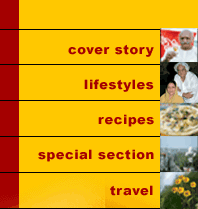
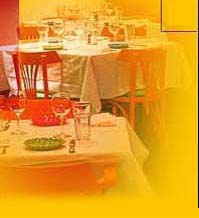

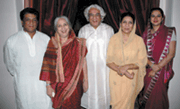 Gaekwadi Cuisine
Gaekwadi Cuisine Maharaja Ranjitsingh Gaekwad of Baroda hosts the UpperCrust to a royal banquet. MARK MANUEL reports from the royal dining hall. |
|
DINNER at the Laxmi Vilas Palace, the seat of Maharaja Ranjitsingh Gaekwad of Baroda, is always a royal affair. Liveried attendants bow you into the Darbar Hall, where Raja Ravi Varma paintings commissioned by the erstwhile Maharaja Sayajirao Gaekwad III in 1888 adorn the walls, and where a grand table has been laid out with the finest crockery and cutlery from the royal kitchen. Maratha musicians sitting outside, playing instruments of old, strike up a loud and sonorous tune, as if preparing for a war or wedding.
The Maharaja courteously greets you in one of his private living rooms, where there is a bar attached, and which room is large enough to hold a dance for 50 couples. It overlooks the vast grounds of Laxmi Vilas Palace, where once wild boar, partridge, peacock, duck and hare roamed about freely, and where the Maharaja now invites VIPS of Baroda to play golf.
He is a handsome man in a leonine way, stylishly dressed in silk churidhar-kurta, not traditionally in royal robes and headgar as the former rulers of Baroda might have. And he has a thick and unruly mane of silver hair that tumbles down almost to his shoulders. Beneath his kurta, he is a rugged heavyweight of a man, with muscular body and thick, powerful hands. “I paint,” he explains simply when I ask him what exercise he does to remain so fit and, well, strong.
The Maharaja, I was to discover, is also something of a humorist. Over dinner, I was to see evidence of his dry and subtle wit which was interspersed by a slow and wintry smile. He is the ruler of Baroda, or at least rckoned to be, so I guess he is entitled to such liberties.
The present day chefs in the Laxmi Vilas Palace who feed Maharaja Ranjitsingh Gaekwad, two fine Maratha gentlemen by the names of Babunarayan Jadhav and Bhikaji Mohite, do not refer to any of these books however. They have been cooking the cuisine for years and know it inside out. The menu for the palace meal is always decided by Maharani Shubhanginiraje Gaekwad daily. And the menus are planned is a most business-like manner. The Maharani decides what she wants her family to eat. The palace chefs, Jadhav and Mohite, enter her menu in a book. This is sent to a store-keeper who notes what ingredients would be required for the royals’ meal. The ingredients are ordered and delivered to the kitchen.
When the Gaekwads are not entertaining, then their lunches are always Indian meals and the dinners are Continental. Gaekwadi cuisine is too rich to have twice a day. The chefs make Continental meals that are comparable to the best in classic French restaurants. The tartare sauce they make is unique. It goes so well with a roast saddle of lamb. When the Gaekwads are dining abroad, they often wish they had carried their own tartare sauce with them! But, the requirement of the chefs is that the lunch could be a heavy meal, whereas dinner is always light... a soup, vegetable, main course and dessert. Sundays, the meals are not just heavy, but they are rich and consist of several courses. “Everybody is at home, that’s why,” says Jadhav with a grin.
On the occasion when the Gaekwads are entertaining, Maharani Shubhanginiraje draws up a menu the previous evening and the next morning, before it is sent to the store-keeper, Maharaja Ranjitsingh will give it a lookover and then nod his approval! Once royal menus are planned, the chefs are left to cook the meals unsupervised. Maharani Shubhanginiraje, who is an elegant and shy lady, reveals with a smile that when she and her husband are travelling abroad, he often cooks for her. “He can cook a whole meal, he is more confident than I am in the kitchen,” she says of Maharaja Ranjitsingh who sits at the head of the dining table majestically watching the service at dinner. “He likes to eat, he is a foodie with adventurous tastes, so he will often experinment with his food,” the Maharani says, adding further insight to the gourmet Maharaja of Baroda.
Nothing much has changed in the Gaekwadi cuisine over the years. The royal kitchen in the palace is smaller than what it was during Maharaja Sayajirao III’s time. He was extravagant, he had one cook making one dish! But the Gaekwad family continues to be one of hearty eaters. Vegetarians dining at the palace are amazed at the variety of non-veg food. There’s very little for them! Some element of meat, fish or eggs is added even to simple vegetarian fare to create new delicacies. They even have a non-vegeterian undhiyu! This is a fine example of fusion cooking. Undhiyu is a Gujarati dish, but to the fresh vegetables and masalas cooking in a mud pot over a slow fire, the Baroda Palace chefs add chicken, boiled eggs and dumplings of kheema. That’s non-veg undhiyu!
The chefs even make their own masala to go with the cuisine. It is called Kala Masala and it is more “garam” than the ubiquitous garam masala. Thirty spices go Kala Masala and a lot of coconut. It is roasted, fried and stored twice a year. The men in the Gaekwad family are all very knowledgeable about food, and they occasionally cook. The son, Prince Samarjitsingh Gaekwad, who is married to Radhika of Wakaner, is quite a foodie himself. He can cook, but complains the kitchen in the Laxmi Vilas Palace is so far from his living quarters, that he does not bother with cooking at all. “I have to walk so much, open so many doors to get there,” he jokes good-naturedly. “But, the strange part is that food tastes better in the kitchen! I love to have my dinner there. It’s not the same as dining at the table. There’s no ceremony, for one thing! And as for cooking, I can, a little, but not an entire meal. If I were living in a flat, then I might have taken up cooking. I’m interested in food. And we entertain a lot.”
Finally, the 25 cookery books. The man who wrote them out was Maharaja Sayajirao III’s kitchen in-charge, Narayan Kadam. He did an inimitably marvellous job. The books are compendiums for anybody interested in Gaekwadi food. He wrote them in Urdu, English and Tamil, and later translated them into Marathi, because the earliest influences on Gaekwadi food were from Continental, Mughlai, Bengal and South Indian cuisines. He’s described Gaekwadi cooking methods and recipes. And provided menus: for sit-down dinners and garden parties; to serve 1,000 people and for a single diner; for an entire month with not a single dish repeated. He’s written on foods meant for religious and festive occasions, and for illnesses. And on how cooks are to be trained, what service they must provide, and what silver and china go with what meal.
|
|
|

Home Page
About the mag
Subscribe
Advertise
Contact Us

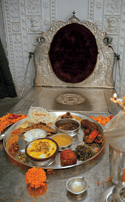 Dinner at the Laxmi Vilas Palace is always Gaekwadi cuisine, the Gaekwad family’s heritage and pride. It is an unique cuisine, you will not taste in anywhere else in India. In fact, not even outside the Laxmi Vilas Palace. It has to be the earliest version of fusion cooking in the country. Maharaja Sayajirao III, a great gourmet and entertainer, was quick to realise this. He saw that the food had evolved because it had been influenced by princesses of the Gwalior, Tanjore and Kolhapur gharanas, and also other states, who had married into the Gaekwad family. These princesses, and a succession of chefs with different cooking styles, changed the original Maratha cuisine of the Baroda palace to suits their tastes. What had developed was being identified as “Gaekwadi” food by those lucky enough to sample it. And a proud Maharaja Sayajirao III decided to present it to the world through books. Several have been written. And they are preserved with great care in the palace museum.
Dinner at the Laxmi Vilas Palace is always Gaekwadi cuisine, the Gaekwad family’s heritage and pride. It is an unique cuisine, you will not taste in anywhere else in India. In fact, not even outside the Laxmi Vilas Palace. It has to be the earliest version of fusion cooking in the country. Maharaja Sayajirao III, a great gourmet and entertainer, was quick to realise this. He saw that the food had evolved because it had been influenced by princesses of the Gwalior, Tanjore and Kolhapur gharanas, and also other states, who had married into the Gaekwad family. These princesses, and a succession of chefs with different cooking styles, changed the original Maratha cuisine of the Baroda palace to suits their tastes. What had developed was being identified as “Gaekwadi” food by those lucky enough to sample it. And a proud Maharaja Sayajirao III decided to present it to the world through books. Several have been written. And they are preserved with great care in the palace museum. 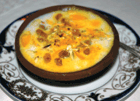 It seems that paintings and food are subjects of great interest at Laxmi Vilas Palace. Every member of the Gaekwad family talks informatively and passionately about art and gastronomy. Maharaja Ranjitsingh is the chairman and managing trustee of the Maharaja Fatesingh Museum of Baroda. His father was a great cook and his elder brother almost came out with a cookery book. The story goes that Maharaja Sayajirao III, who was Maharaja Ranjitsingh’s great-grandfather and who ruled Baroda between 1875 and 1939, commissioned the single largest collection of Raja Ravi Varma’s works in the world. He also believed good food led to good health and a good life, and so commissioned 25 books on the unique Gaekwadi cuisine that was being made in the traditional kitchen of the palace. Like the paintings, these books are part of the Gaekwad family’s heritage.
It seems that paintings and food are subjects of great interest at Laxmi Vilas Palace. Every member of the Gaekwad family talks informatively and passionately about art and gastronomy. Maharaja Ranjitsingh is the chairman and managing trustee of the Maharaja Fatesingh Museum of Baroda. His father was a great cook and his elder brother almost came out with a cookery book. The story goes that Maharaja Sayajirao III, who was Maharaja Ranjitsingh’s great-grandfather and who ruled Baroda between 1875 and 1939, commissioned the single largest collection of Raja Ravi Varma’s works in the world. He also believed good food led to good health and a good life, and so commissioned 25 books on the unique Gaekwadi cuisine that was being made in the traditional kitchen of the palace. Like the paintings, these books are part of the Gaekwad family’s heritage.